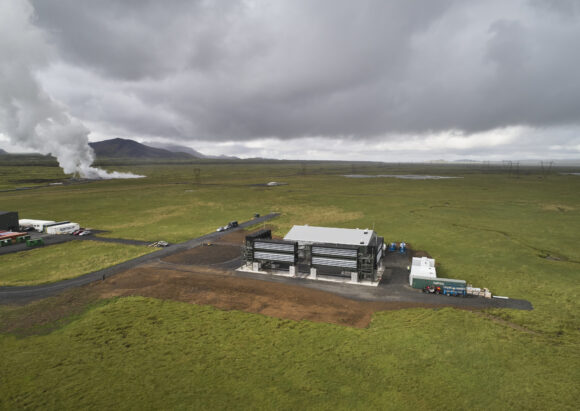To achieve net-zero emissions, where emissions and removals of greenhouse gas pollution balance each other out, governments and corporations must do two things: cut emissions as much as possible and remove any residual pollution from the atmosphere.
To gauge the speed at which emissions must be reduced, analysts often use the so-called carbon budget, a well-established framework for calculating the amount of greenhouse gases that can be emitted to remain at or below a given level of global warming. (World leaders have committed to holding the increase in the global average temperature to well below 2C above pre-industrial levels, and ideally to 1.5C)
But quantifying the amount of carbon dioxide removal available to help realize such temperature goals is a less well-trodden area of analytical focus. So University of Oxford researchers just devised a “carbon removal budget” to address the issue.
Think of carbon removals as the “net” in net zero. CO2 can be removed in many ways, including via nature-based approaches like restoring forests or peatland. There are also technologies like direct air capture and storage, so-called biochar and bioenergy and carbon capture and storage (BECCS).
But much of this technology hasn’t reached its full potential — and time is running out. The planet is warming so fast that without rapid and drastic action, it’s near certain to overshoot the critical 1.5C threshold. As such, the need to scale technologies and projects that can pull down billions of tons of planet-warming gases to lower global temperatures becomes essential.
The Oxford academics who authored the paper, Ben Caldecott and Injy Johnstone, argue that while it’s essential for this industry to grow if we are to have any chance of hitting net zero, CO2 removal will always be “a fundamentally finite resource” that should be allocated responsibly.
“Carbon removals are not free and face some significant economic constraints,” Caldecott said in an interview. “So if a company that could easily abate emissions decides instead to use a chunk of the available carbon removal budget, what will that mean for other actors? There has to be equity in the way this finite resource is distributed, and there will undoubtedly be tradeoffs.”
In other words, industries that can more easily cut emissions should maximize that effort, leaving more of the world’s limited capacity to remove carbon from the atmosphere for those that, because of their very nature, are limited in their ability to do so. Companies in so-called “hard to abate” sectors like steelmakers and airlines might have greater need for such removals under certain scenarios, the authors said.
The capacity for CO2 removal and storage is generally constrained by physics, as well as a range of economic, institutional and technological barriers. As such, Caldecott and Johnstone said, “who has the right to access already feasible CO2 removal as well as who bears the onus of developing further potential,” remain important questions.
So how much carbon do we need to remove from the atmosphere, and at what cost to achieve our climate goals? And what’s possible given the current state of carbon removal technology?
Assuming a minimum price-per-ton of carbon removed of $100, and taking into account what’s actually feasible from a technical and economic standpoint (not to mention policy variables), the authors estimate that between 2025 and 2100 the world will face a carbon removal shortfall of 49 gigatons of CO2 in a scenario where warming is kept to about 1.5C.
A deficit implies the need for carbon removals will outstrip forecasted deployment of such technologies.
Now if humanity wanted to settle for 2C warming, which could be catastrophic from a climate change standpoint, there’s potential for a small surplus of 12 gigatons of CO2 when it comes to the carbon removal budget.
Nature does not have unlimited capacity to store carbon. And all natural carbon sinks could eventually release some stored CO2 back into the atmosphere. Meanwhile, novel carbon removal techniques such as direct air capture, where machines suck CO2 from the atmosphere and bury it deep underground, have a lower risk of reversal. But they also come with costs as high as $1,610 per ton for the most complex technologies. And it can take a long time to develop the necessary infrastructure.
“Carbon removals are like the new gold,” said Johnstone. “They’re highly valuable, are scarce and need to be reserved for only a select number of use cases.”
Robert Höglund, a CO2 removal expert, takes a different view. He says the primary constraint on the amount of removals “isn’t depletable resources — but willingness to pay.”
Where he does agree with Caldecott and Johnstone is that while removals need to be scaled, the first priority of corporations and governments that wish to remove carbon should be to cut emissions. “We should plan as if CO2 removal will be scarce, but build for it to be abundant,” he said.
“There are large uncertainties about our ability to remove CO2 and the focus should be on conserving the initial carbon budget,” said Johnstone. “Any conversation about carbon removals needs to start with the fact it’s a lot easier to reduce emissions than pull them back out of the atmosphere.”
Sustainable finance in brief
Another Wall Street giant appears to be caving in to the far right’s crusade against ESG on behalf of Big Oil and others. The asset management unit of Goldman Sachs Group Inc. walked away from the world’s biggest climate alliance for investors, marking the latest in a string of similar defections amid continued Republican attacks on green finance. The departure feeds into a broader trend as financial firms are increasingly running scared from opponents of environmental, social and governance investing strategies.
- Climate groups are intensifying warnings about Project 2025, the plan by allies of Donald Trump to eviscerate government regulations including environmental protections if he wins in November.
- The Biden administration is offering Qcells as much as $1.45 billion in conditional financing to construct the biggest US plant producing silicon ingots and wafers, the building blocks of solar panels.
- Red state Republicans who opposed President Joe Biden’s climate legislation are now warning Trump against defunding projects in their districts.
Photo: A direct air capture and storage facility operated by Climeworks AG in Iceland. Photographer: Bloomberg
Was this article valuable?
Here are more articles you may enjoy.



 WTW to Acquire Newfront in Deal Worth Up to $1.3B
WTW to Acquire Newfront in Deal Worth Up to $1.3B  One of Highest Property Claims Severity Recorded in Q3 on Low Volume, Says Verisk
One of Highest Property Claims Severity Recorded in Q3 on Low Volume, Says Verisk  What to Expect in 2026: US P/C Results More Like 2024
What to Expect in 2026: US P/C Results More Like 2024  Acrisure to Buy MGA Vave From Canopius
Acrisure to Buy MGA Vave From Canopius 

